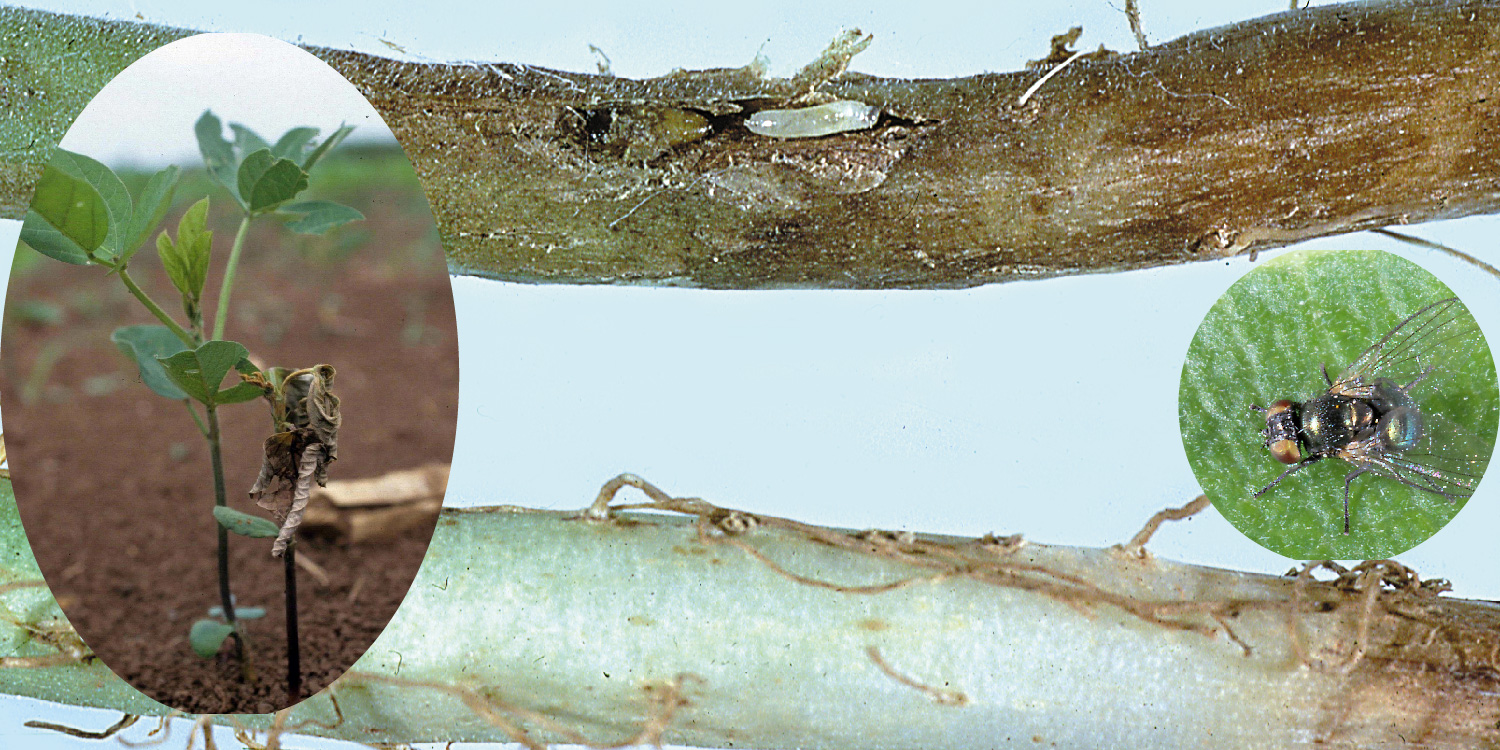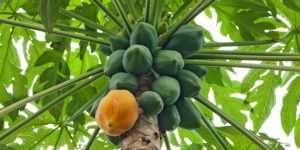Bean fly (Ophiomyia phaseoli) is a stem damaging insect, capable of causing premature plant death, especially in seedlings.
Hosts
Bean fly attacks most of the leguminous crops, like common bean, cowpea, French beans, among others.
Life Cycle
Female flies lay their eggs near the leaf stalks of the tender/ young leaves. These eggs hatch into maggots. There are three stages over about 10 days, and then the maggots pupate. This occurs at the stem/root junction or in older plants at the junction of leaf blade and leaf stalk. Pupation lasts about 10-12 days depending on temperature.
Identification
Adults are small, about 3mm long and shiny black-bluish in colour, with clear wings, about 5mm wide.
Eggs are tiny, white and oval
The larvae or maggots are cream with dark mouthparts and are about 3mm in length.
Pupae are small, brown and cylindrical with rounded ends.
Factors Favoring Bean Fly
- Presence of previously infested crop debris
- Lack of crop rotation
- Poor sanitation of previous legume and weed debris
- Use of contaminated seed
- Planting susceptible varieties
Feeding & Damage
Both the adults and the larvae cause damage.
Crops are at greatest risk for three to four weeks from emergence, but later crops are sometimes attacked.
Larvae feeding soon after hatching produce numerous larval mines which are better seen on the underside of the leaves just under the epidermis, and appear as silvery, curved stripes. On the upper side of the leaf only a few tunnels are visible. Later, both egg holes and larval mines turn dark brown and are clearly visible.
In cases of severe attack, infested leaves become blotchy and later hang down. These leaves may dry out and may even be shed.
When mature plants become infested, insect damage is confined to the leaf petioles, which become swollen and at times the leaves may wilt.
The developing larvae in second and third instar mine downward into the cortex just underneath the epidermis. The third instar continues to feed downwards into the tap root and returns to pupate still inside the stem, close to the soil surface and the feeding tunnels are clearly visible on the stems.
If the larvae population is high, feeding leads to destruction of the cortex tissue around the root-shoot junction. This initially leads to yellowing of the leaves, stunting of plant growth and even plant death.
If the damage is less severe, the root-shoot junction area appears swollen and in some cases the host plant produces adventitious roots above this swollen area on the stem.
The adults make holes in the young leaves as they feed and lay eggs. The female fly pierces the young leaves to lay eggs and sucks the exuding sap. This leaves yellow blotches on the leaves, which are the first signs of bean fly attack and may serve as early symptom useful for monitoring the presence of the pest in the field.
Damage is more severe in plants growing under poor conditions such as infertile soils and drought.
Control
Chemical method
Systemic insecticides should be used for effective control of bean flies.
These include;
- KINGCODE ELITE 50EC
- LEXUS 247SC
- SINOPHATE 750SP
- EMERALD 200SL
- LOYALTY 700WDG
- PROFILE 440EC
- PRESENTO 200SP
NOTE
- Seeds dressed with SHIELD 600FS before planting are not susceptible to attack by bean fly.
- Whenever doing foliar sprays, it is advisable to mix the insecticide with INTEGRA 3ml/20l, which is a sticker, spreader and penetrant. It improves the efficacy of the chemical
- To prevent resistance build-up by the insect, several insecticides should be alternated in a crop’s season, instead of using a single one.
- Timely application of the insecticide(s) is very critical.
- Seedling crops should be monitored at least twice a week
Non-chemical methods
- Early planting. Bean fly numbers tend to be low during the early stages of the growing season and increase with time.
- Maintenance of field hygiene/sanitation.
- Provide favourable growing conditions to improve plant vigour and to enhance tolerance to insect attack and damage
- Mulching, e.g. with straw and cut grasses helps conserve moisture, promote adventitious root development and enhances tolerance to maggot damage.
- Crop rotation with non-host crops
- Proper weed control
- Remove and destroy crop residues and all plant parts with symptoms of damage by bean flies.
- Earthing /building up the soil around the plants to cover the roots at 2-3 weeks after emergence. This helps the adventitious roots to grow more quickly.
- Use of resistant varieties
- Use of sticky traps to catch the adult flies






